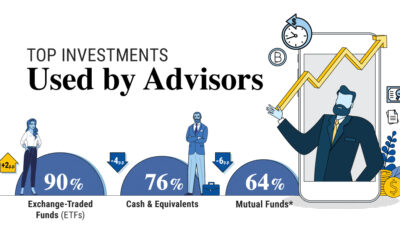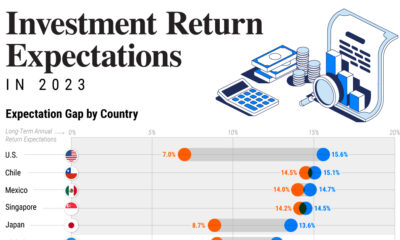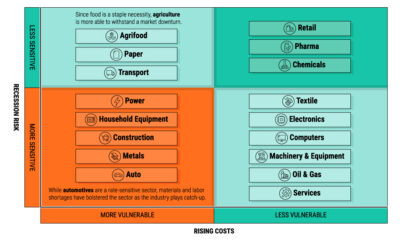Inflation Projections, by Country in 2024
Global economic prospects hang on a delicate balance, largely hinging on the path of inflation.
While inflation looks to be easing, there remains the risk of a second wave of price pressures driven by geopolitical conflicts and supply disruptions in the Red Sea. Adding to this, a stronger than expected labor market could drive consumer demand, pushing up higher prices.
This graphic shows 2024 inflation projections around the world, based on forecasts from the International Monetary Fund (IMF).
Is Global Inflation On a Downward Path?
In 2024, global inflation is projected to decline to 5.8%, down from a 6.8% estimated annual average in 2023.
Tighter monetary policy and falling energy prices are forecast to dampen price pressures alongside a cooling labor market. Below, we show inflation projections across 190 countries:
| Country | Projected Annual Inflation Change 2024 |
| 🇻🇪 Venezuela | 230.0% |
| 🇿🇼 Zimbabwe | 190.2% |
| 🇸🇩 Sudan | 127.3% |
| 🇦🇷 Argentina | 69.5% |
| 🇹🇷 Türkiye | 54.3% |
| 🇪🇬 Egypt | 25.9% |
| 🇦🇴 Angola | 25.6% |
| 🇮🇷 Iran | 25.0% |
| 🇧🇮 Burundi | 22.4% |
| 🇸🇱 Sierra Leone | 21.7% |
| 🇸🇷 Suriname | 20.0% |
| 🇪🇹 Ethiopia | 18.5% |
| 🇵🇰 Pakistan | 17.5% |
| 🇳🇬 Nigeria | 15.4% |
| 🇲🇼 Malawi | 15.2% |
| 🇬🇭 Ghana | 15.0% |
| 🇾🇪 Yemen | 15.0% |
| 🇲🇳 Mongolia | 12.8% |
| 🇭🇹 Haiti | 12.7% |
| 🇺🇿 Uzbekistan | 10.7% |
| 🇹🇳 Tunisia | 10.6% |
| 🇹🇲 Turkmenistan | 10.0% |
| 🇺🇦 Ukraine | 10.0% |
| 🇲🇬 Madagascar | 8.6% |
| 🇰🇬 Kyrgyz Republic | 8.0% |
| 🇿🇲 Zambia | 7.9% |
| 🇲🇺 Mauritius | 7.8% |
| 🇬🇳 Guinea | 7.8% |
| 🇰🇿 Kazakhstan | 7.5% |
| 🇧🇩 Bangladesh | 7.2% |
| 🇲🇲 Myanmar | 7.2% |
| 🇸🇹 São Tomé and Príncipe | 7.2% |
| 🇬🇲 The Gambia | 7.1% |
| 🇨🇩 Democratic Republic of the Congo | 7.1% |
| 🇩🇿 Algeria | 6.8% |
| 🇹🇯 Tajikistan | 6.5% |
| 🇳🇵 Nepal | 6.5% |
| 🇰🇪 Kenya | 6.5% |
| 🇲🇿 Mozambique | 6.5% |
| 🇹🇴 Tonga | 6.2% |
| 🇸🇸 South Sudan | 6.1% |
| 🇱🇷 Liberia | 6.0% |
| 🇺🇾 Uruguay | 5.7% |
| 🇻🇺 Vanuatu | 5.6% |
| 🇵🇱 Poland | 5.5% |
| 🇬🇾 Guyana | 5.5% |
| 🇷🇼 Rwanda | 5.5% |
| 🇭🇺 Hungary | 5.4% |
| 🇳🇦 Namibia | 5.3% |
| 🇬🇶 Equatorial Guinea | 5.2% |
| 🇧🇹 Bhutan | 5.1% |
| 🇦🇿 Azerbaijan | 5.0% |
| 🇯🇲 Jamaica | 5.0% |
| 🇱🇸 Lesotho | 5.0% |
| 🇲🇩 Moldova | 5.0% |
| 🇷🇺 Russia | 5.0% |
| 🇺🇬 Uganda | 5.0% |
| 🇳🇮 Nicaragua | 4.8% |
| 🇵🇬 Papua New Guinea | 4.7% |
| 🇷🇴 Romania | 4.7% |
| 🇬🇹 Guatemala | 4.6% |
| 🇼🇸 Samoa | 4.5% |
| 🇿🇦 South Africa | 4.5% |
| 🇸🇰 Slovak Republic | 4.5% |
| 🇨🇴 Colombia | 4.5% |
| 🇮🇳 India | 4.4% |
| 🇧🇼 Botswana | 4.4% |
| 🇸🇿 Eswatini | 4.3% |
| 🇱🇻 Latvia | 4.3% |
| 🇭🇳 Honduras | 4.2% |
| 🇳🇷 Nauru | 4.2% |
| 🇧🇪 Belgium | 4.0% |
| 🇮🇸 Iceland | 4.0% |
| 🇹🇿 Tanzania | 4.0% |
| 🇰🇮 Kiribati | 4.0% |
| 🇲🇷 Mauritania | 4.0% |
| 🇵🇾 Paraguay | 4.0% |
| 🇷🇸 Serbia | 4.0% |
| 🇩🇴 Dominican Republic | 4.0% |
| 🇦🇲 Armenia | 4.0% |
| 🇧🇷 Brazil | 3.9% |
| 🇸🇴 Somalia | 3.9% |
| 🇹🇻 Tuvalu | 3.8% |
| 🇧🇴 Bolivia | 3.8% |
| 🇧🇾 Belarus | 3.7% |
| 🇨🇲 Cameroon | 3.7% |
| 🇽🇰 Kosovo | 3.7% |
| 🇪🇪 Estonia | 3.6% |
| 🇧🇧 Barbados | 3.6% |
| 🇸🇧 Solomon Islands | 3.6% |
| 🇦🇱 Albania | 3.6% |
| 🇦🇺 Australia | 3.4% |
| 🇪🇸 Spain | 3.4% |
| 🇵🇭 Philippines | 3.4% |
| 🇻🇳 Vietnam | 3.4% |
| 🇲🇦 Morocco | 3.3% |
| 🇸🇮 Slovenia | 3.3% |
| 🇦🇹 Austria | 3.2% |
| 🇭🇷 Croatia | 3.2% |
| 🇨🇬 Republic of Congo | 3.2% |
| 🇳🇴 Norway | 3.2% |
| 🇸🇬 Singapore | 3.2% |
| 🇲🇽 Mexico | 3.2% |
| 🇹🇩 Chad | 3.1% |
| 🇲🇪 Montenegro | 3.1% |
| 🇱🇹 Lithuania | 3.1% |
| 🇨🇷 Costa Rica | 3.0% |
| 🇰🇭 Cambodia | 3.0% |
| 🇮🇹 Italy | 3.0% |
| 🇨🇱 Chile | 3.0% |
| 🇬🇪 Georgia | 3.0% |
| 🇬🇼 Guinea-Bissau | 3.0% |
| 🇮🇶 Iraq | 3.0% |
| 🇱🇦 Lao P.D.R. | 3.0% |
| 🇫🇲 Micronesia | 3.0% |
| 🇩🇲 Dominica | 2.9% |
| 🇸🇪 Sweden | 2.8% |
| 🇩🇪 Germany | 2.8% |
| 🇬🇷 Greece | 2.7% |
| 🇲🇾 Malaysia | 2.7% |
| 🇮🇪 Ireland | 2.6% |
| 🇯🇵 Japan | 2.6% |
| 🇫🇯 Fiji | 2.6% |
| 🇲🇭 Marshall Islands | 2.6% |
| 🇬🇩 Grenada | 2.6% |
| 🇺🇸 United States | 2.6% |
| 🇵🇹 Portugal | 2.6% |
| 🇮🇱 Israel | 2.6% |
| 🇧🇸 The Bahamas | 2.6% |
| 🇯🇴 Jordan | 2.6% |
| 🇱🇾 Libya | 2.5% |
| 🇳🇿 New Zealand | 2.5% |
| 🇧🇯 Benin | 2.5% |
| 🇩🇰 Denmark | 2.5% |
| 🇩🇯 Djibouti | 2.5% |
| 🇸🇲 San Marino | 2.5% |
| 🇹🇱 Timor-Leste | 2.5% |
| 🇮🇩 Indonesia | 2.5% |
| 🇦🇬 Antigua and Barbuda | 2.5% |
| 🇳🇪 Niger | 2.5% |
| 🇨🇫 Central African Republic | 2.5% |
| 🇵🇸 West Bank and Gaza | 2.5% |
| 🇲🇻 Maldives | 2.4% |
| 🇲🇹 Malta | 2.4% |
| 🇳🇱 Netherlands | 2.4% |
| 🇸🇨 Seychelles | 2.4% |
| 🇬🇧 United Kingdom | 2.4% |
| 🇬🇦 Gabon | 2.4% |
| 🇰🇳 St. Kitts and Nevis | 2.3% |
| 🇭🇰 Hong Kong SAR | 2.3% |
| 🇲🇰 North Macedonia | 2.3% |
| 🇦🇪 UAE | 2.3% |
| 🇹🇹 Trinidad and Tobago | 2.3% |
| 🇶🇦 Qatar | 2.3% |
| 🇵🇦 Panama | 2.2% |
| 🇸🇦 Saudi Arabia | 2.2% |
| 🇵🇪 Peru | 2.2% |
| 🇨🇾 Cyprus | 2.2% |
| 🇨🇿 Czech Republic | 2.2% |
| 🇹🇬 Togo | 2.2% |
| 🇧🇬 Bulgaria | 2.2% |
| 🇦🇼 Aruba | 2.2% |
| 🇨🇦 Canada | 2.1% |
| 🇧🇦 Bosnia and Herzegovina | 2.1% |
| 🇱🇨 St. Lucia | 2.1% |
| 🇦🇩 Andorra | 2.0% |
| 🇧🇫 Burkina Faso | 2.0% |
| 🇨🇻 Cabo Verde | 2.0% |
| 🇨🇮 Côte d'Ivoire | 2.0% |
| 🇰🇷 Korea | 2.0% |
| 🇲🇱 Mali | 2.0% |
| 🇻🇨 St. Vincent and the Grenadines | 2.0% |
| 🇨🇭 Switzerland | 1.9% |
| 🇵🇷 Puerto Rico | 1.9% |
| 🇨🇳 China | 1.9% |
| 🇫🇮 Finland | 1.9% |
| 🇫🇷 France | 1.9% |
| 🇹🇼 Taiwan | 1.8% |
| 🇵🇼 Palau | 1.8% |
| 🇹🇭 Thailand | 1.8% |
| 🇱🇺 Luxembourg | 1.7% |
| 🇸🇻 El Salvador | 1.7% |
| 🇲🇴 Macao SAR | 1.7% |
| 🇴🇲 Oman | 1.7% |
| 🇰🇲 Comoros | 1.6% |
| 🇧🇳 Brunei Darussalam | 1.5% |
| 🇪🇨 Ecuador | 1.5% |
| 🇧🇭 Bahrain | 1.4% |
| 🇧🇿 Belize | 1.2% |
| 🇸🇳 Senegal | 0.3% |
Venezuela, with the largest oil reserves globally, is projected to see inflation reach 230%—the highest overall.
Across the last decade, the country has faced hyperinflation, reaching a stunning 10 million percent in 2019. Since U.S. sanctions were lifted last year, inflation has fallen dramatically due to sharp cuts in government spending and increasing dollarization of the economy, which is bolstering the bolivar.
In America, slower economic growth coupled with a softening labor market could ease inflation, which is forecast to reach 2.6% in 2024. While the Federal Reserve has signaled that the worst is over, unexpected momentum across the economy could cloud the outcome. As of November 2023, $290 billion in excess savings were held across American households, which may continue to spur consumer demand.
Over in Europe, inflation is anticipated to average 3.3% across advanced economies. Today, sinking natural gas prices and low GDP growth are keeping inflation expectations at bay.
China, the world’s second-largest economy, is contending with falling prices due to property market trouble, which drives about a third of the country’s economic growth. Amid sluggish economic activity, a manufacturing slowdown, and low consumer confidence, inflation is forecast to reach 1.7%.
What Could Cause Inflation to Re-Accelerate?
While inflation shocks driven from the pandemic appear to be over, key risks could drive up inflation:
- Geopolitical Pressures: Rising shipping costs due to the conflict in the Middle East and Red Sea could continue to escalate and energy prices could increase amid disrupted supply, driving inflation higher.
- Strong Consumer Demand: Accumulated excess savings could continue to fuel economies, leading central banks to remain hawkish. Persistently high wage growth—which increased about double the pre-pandemic average across advanced nations in 2023—could boost consumption and higher prices.
- Rising Housing Costs: Shelter makes up about a third of the Consumer Price Index, the biggest component overall. If prices accelerate, it presents key inflationary risks. As of January 2024, U.S. shelter costs increased 6% annually.
So far, the global economy has been resilient. While risk factors remain, inflation projections suggest that the path towards a 2% target is slow, but going in the right direction.

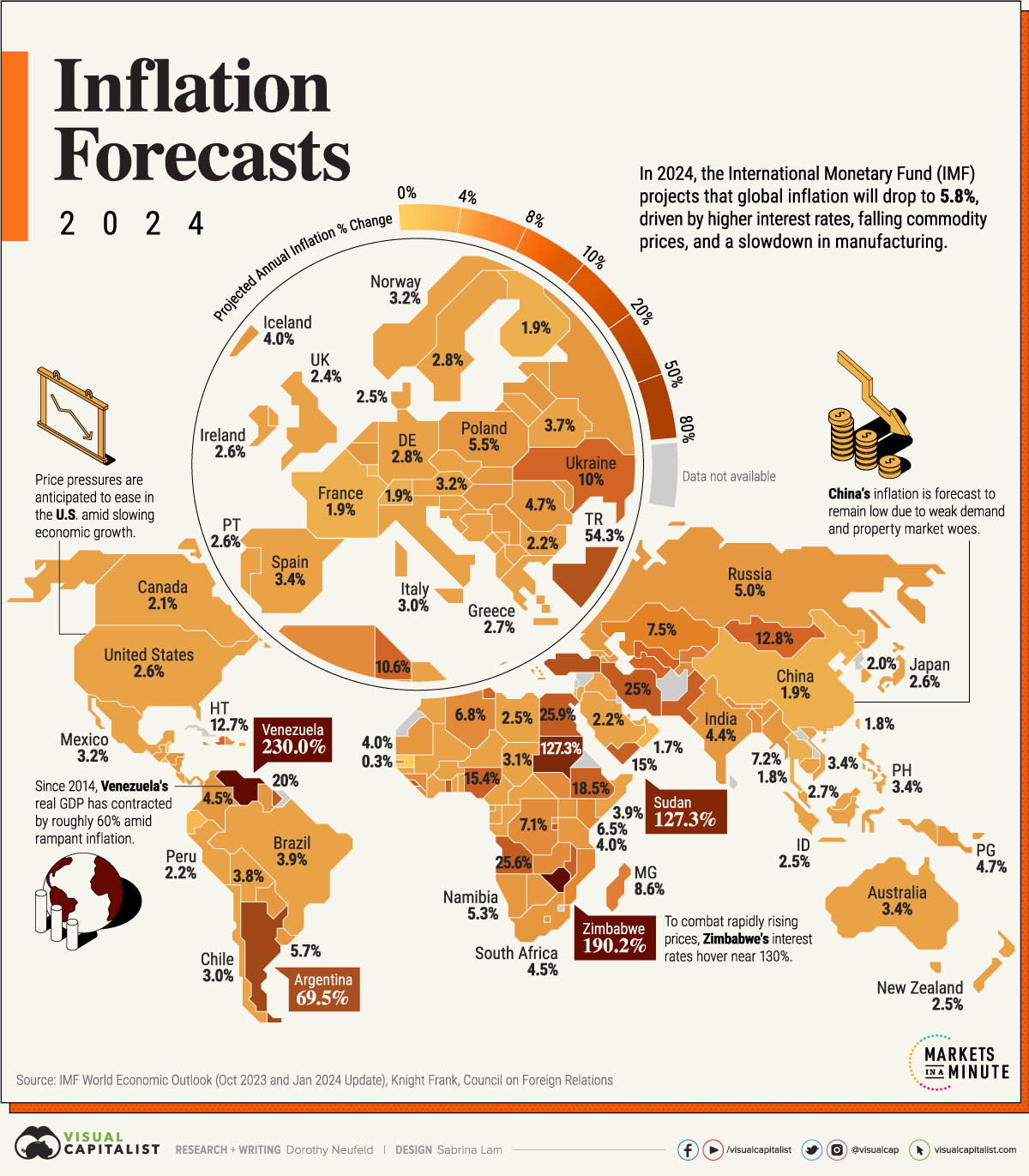
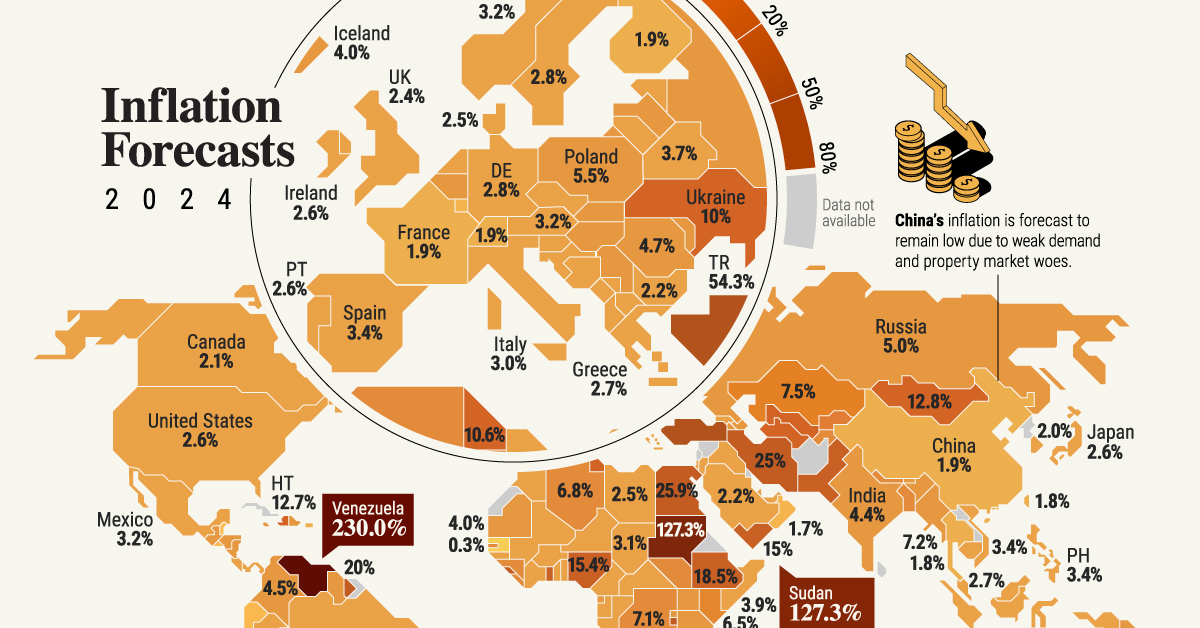

 Infographics2 years ago
Infographics2 years ago
 Markets in a Minute2 years ago
Markets in a Minute2 years ago
 Markets in a Minute2 years ago
Markets in a Minute2 years ago
 Infographics2 years ago
Infographics2 years ago
 Markets in a Minute1 year ago
Markets in a Minute1 year ago
 Markets in a Minute2 years ago
Markets in a Minute2 years ago
 Infographics1 year ago
Infographics1 year ago
 Markets in a Minute2 years ago
Markets in a Minute2 years ago



